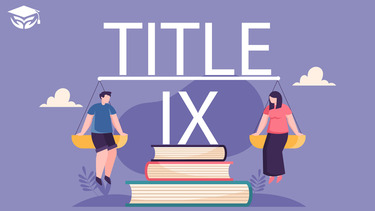
What is Title IX of the Education Amendments Act?
Over the period, the human race has made amends in the system of functioning to better the striving situation for themselves. Notable developments have taken place to enhance the quality of living. Title IX of the Education Amendments Act of 1972 is one of the prominent developments in the federal government’s history. This act and amendment ensure that no gender-based discrimination occurs at educational institutions.
The Title IX, prohibits gender discrimination based on sex or gender at any educational institution aided or funded by federal finances. Title IX plainly says:
“No person in the United States shall, on the basis of sex, be excluded from participation in, be denied the benefits of, or be subjected to discrimination under any educational program or activity receiving Federal financial assistance”.
Earlier, Title IX of the Education Amendments of 1972 was identified as Patsy Takemoto Mink Education Act. It was named after the co-author of the act, yet with time and certain amendments, it is officially known as Title IX of the Education Amendments of 1972. The following act comprises notable rules and regulations that educational institutions must follow to comply with the federal suggested norms and regulations.
Who enforces the Title IX Act?
Title IX is governed by the U.S. Department of Education’s Office for Civil Rights. In 1972, Congress passed Title IX, an amendment to the Civil Rights Act, which ensured These authorities looked into the matter of law enforcement. The lawmaking system interprets the socially prevailing situation and suggests laws that stabilize society’s law and order domain. Also, certain laws and amendments occur after observing the need for developments in the existing code of the system.
The Purpose of the Act
The target stakeholder of Title IX of the Education Amendments Act is educational institutions and authorities working on the funds aided by the federal government. This act assures whether the prevailing educational institutes are eternally complaining towards the federal government. Existing educational institutions must accept the suggested rules and regulations in the federal territory.
This amendment expects certain targeted stakeholders to stay compliant. Otherwise, legal authorities intervene in the required situation. Whenever any educational institution located in the federal territory is reported under Title IX of the Education Amendments Act, a lawsuit is charged against that institution.
Why was Title IX created?
The following act was in motion to establish educational institutions as a discrimination-free zone. Generally, at that time, gender-based discrimination was frequent and affected the social status of women in the country. Title IX was implemented to make institutions a better place for citizens and provide a safe environment for women at the institutions.
How did Title IX impact American education?
With the enforcement of Title IX, American Educational Institutions paved the way toward development and progression. After Title IX, womens who aspire to pursue higher education were shielded from gender-based discrimination or prejudice against them at educational institutions. Institutions were strict about staying compliant; otherwise, consequences were legally strict. Educational Institutions started having a sensitive approach to handling sexual harassment or physical harassment complaints. In the beginning, the act wasn’t welcomed by the citizens as the stereotypical mentality dominated most of the population. Yet, with the period and certain developments, the act counted the status of consideration.
Title IX prevents gender discrimination in all of the following areas except non-educational institutions funded by the federal government. Title IX solely intervenes in sexual harassment at educational institutions funded and aided by federal funding. It looks into the matter of sex-based discrimination and prejudices against women.
Sexual Harassment and Sexual Violence under the Act
Despite the influence of Title IX, it has been difficult to achieve gender equity in schools where a male-dominant mentality prevails. Title IX defines sexual harassment is unwelcomed advances in sexual terms, visuals, physically or audibly. As prejudice prevailed at that time, the condition of women studying at educational institutions was worst. The data of recorded and unrecorded exploitation cases were high. Yet, the federal government introduced Title IX to stabilize this situation to attain stability from discrimination and prejudice against women.
Title IX of the Education Amendments Act of 1972 requires schools to comply with the suggested law system. The Title IX basic requirement to stay custodian to establish federal-funded education institutions, vocational institutions, and other extracurricular oriented institutes.
Title IX and Sports
The inclusion of sports in educational institutions has been through disagreements. Yet, sports were considered an essential part of educational institutions with certain amendments. It meant that half of the students should exist in a federal aided educational institution, equal to students enrolling themselves in the educational institutions solely for academic purposes.
In 1996, the Athletic Disclosure Act finalized the inclusion of sports programs as a mandatory program for educational institutions. It started with a separate execution of both genders’ sports programs. With time the idea of normalizing participation of women in sports and athletic activities got normal. And their representation in the athletic domain in educational institutions got notified.
The Current Status of Title IX of the Education Amendments Act
Focusing on the current emphasis of Title IX, The Clery Act reflects on the documentation of all the crime and misconduct data taking place under the territory of an educational institution. To prevent sex discrimination, educational institutions should have an effective and prompt approach to react in certain situations.
Institutions must embed and distribute a policy against sex-based discrimination. Institutions must have a Title IX coordinator in the face of counsellors who acquire knowledge to handle such situations. And lastly, educational institutions must introduce a known procedure for prevailing students on how to file a complaint of sex discrimination.
What would be a violation of Title IX?
Usually, if any educational institution is tolerant of sex discrimination and prejudice and isn’t taking any strict actions against it or isn’t recommending the criminal filing of a case, then that educational institution would be held accountable for violating Title IX. It relies on the matter of tolerance and approaches an institution has towards such sensitive matters and how they’re interpreting them.




